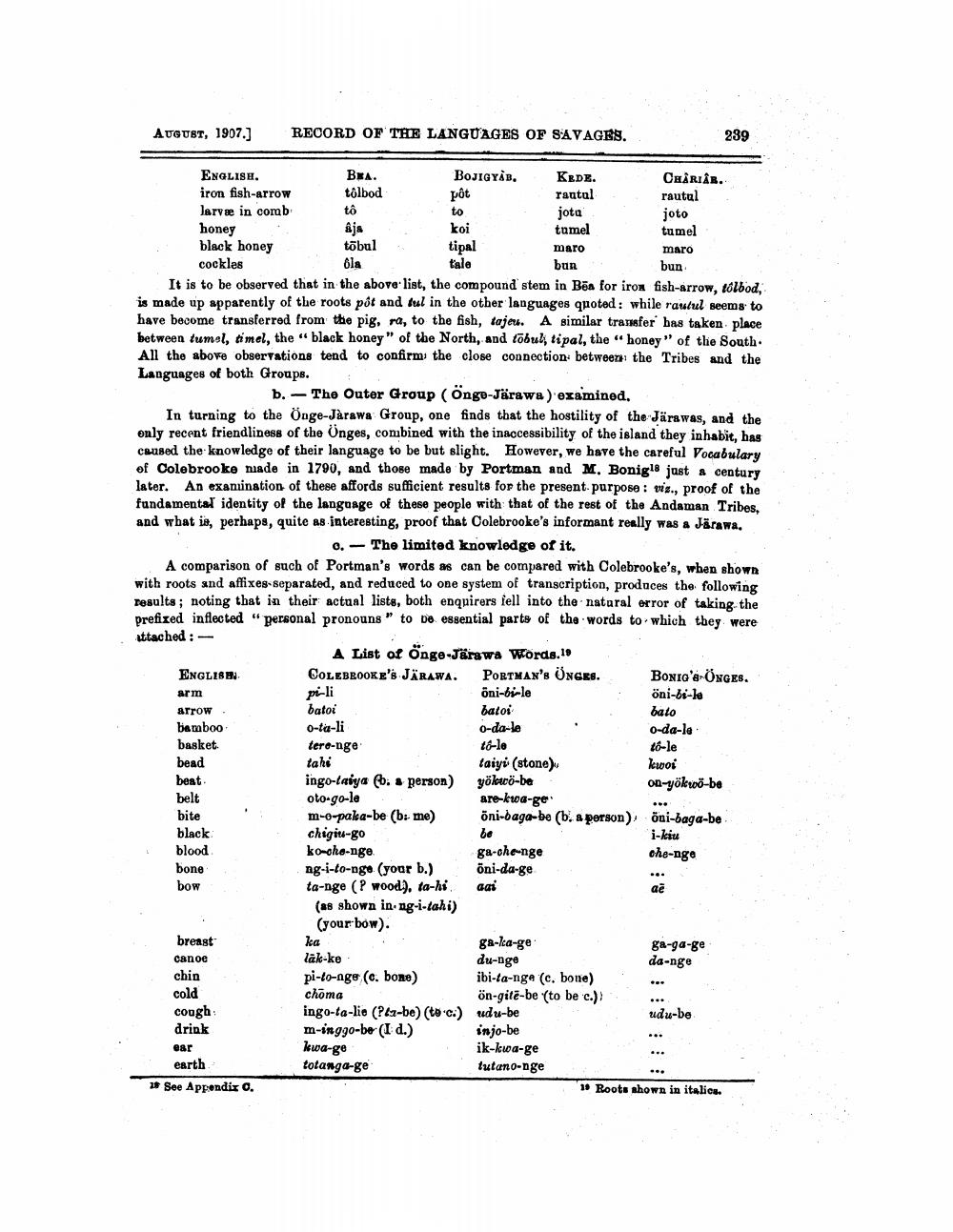________________
RECORD OF THE LANGUAGES OF SAVAGES.
joto
ola
ENGLISH,
BEA. BOJIGYAB. KEDE.
CHRIÂR. iron fish-arrow tôlbod
pôt rautal
rautal larvæ in comb tô
to
jota honey
aja koi tumel
tumel black honey tõbulo tipal
maro
maro cockles
tale bun
bun It is to be observed that in the above list, the compound stem in Bēn for iron fish-arrow, tolbod, is made up apparently of the roots pót and ful in the other languages quoted: while rautul seems to have become transferred from the pig, na, to the fish, tajer. A similar transfer has taken place between tumel, timel, the black honey" of the North, and tobul, tipal, the "honey" of the South. All the above observations tend to confirm the close connection between the Tribes and the Languages of both Groups.
b. - The Outer Group (Öngo-Järawa ) examined. In turning to the Önge-Járawa Group, one finds that the hostility of the Järawas, and the only recent friendliness of the Unges, combined with the inaccessibility of the island they inhabit, has caused the knowledge of their language to be but slight. However, we have the careful Vocabulary of Colebrooke made in 1790, and those made by Portman and M. Bonigle just a century later. An examination of these affords sufficient results for the present purpose: vie., proof of the fundamental identity of the language of these people with that of the rest of the Andaman Tribes, and what is, perhaps, quite as interesting, proof that Colebrooke's informant really was a Järawa.
0.- The limited knowledge of it. A comparison of such of Portman's words as can be compared with Colebrooke's, when shown with roots and affixes separated, and reduced to one system of transcription, produces the following results; noting that in their actual lists, both enquirers fell into the nataral error of taking the prefixed inflected personal pronouns" to be essential parts of the words to which they were attached :
A List of Önge-Járawa Words.10 ENGLISH
COLEBROOKE'S JÄRAWA. PORTMAN'S ÖNCES. BONIG'S-ONGES. arm pi-li öni-bi-le
öni-bi-la arrowbatoi batoi
bato bamboo 0-ta-li 0-da-le
0-da-le basket tero-nge td-le
tô-le bead tahi taiyö (stone)
kwoi beat ingo-latya b. a person) yölscö-be
on-yökrő-be belt oto-go-le
are-kwa-ge bite
m-o-paka-be (b. me) öni-baga-be (b. a person), ni-baga-be black chigit-go
i-kiu blood koncho-nge ga-che-nge
che-nge bone
ng-i-to-ngo (your b.) öni-da-ge bow ta-nge (P wood), ta-hi dai
ae (as shown in. ng-i-tahi)
(your bow). breast ka ga-la-ge
ga-ga-ge Canoe lak-ke du-nge
da-nge chin
pi-to-nge (c. bone) ibi-ta-nge (c. bone) cold choma
ön-gita-be (to be c.) cough ingo-ta-lie (?la-be) (to c) udr-be
udu-be drink m-inggo-be (I d.)
injo-be ear kwa-ge
ik-kwa-ge earthtotanga-ge
tutano-nge * See Appendix C.
1. Roots shown in italice.
be




